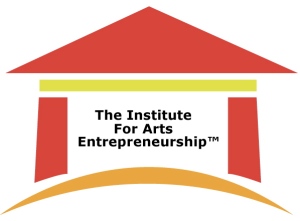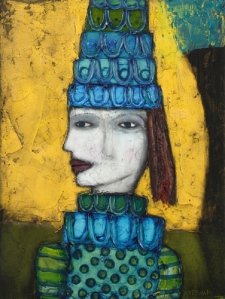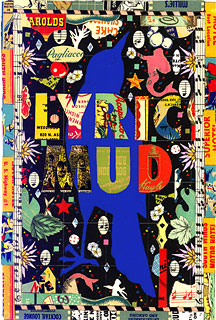 My name is Lisa Canning. I am an artist-a musician. I am also an artistic entrepreneur- a business-woman- and the founder of ETA.
My name is Lisa Canning. I am an artist-a musician. I am also an artistic entrepreneur- a business-woman- and the founder of ETA.
As long as I can remember, the arts have been perceived by most I know in the business world as visceral in nature–at best a sort of “soft” asset that has no place on their profit and loss statement or balance sheet. Relegated to lobby foyers, museum like executive art collections, the work of the marketing department, shared experiences when courting a new client and a source of entertainment for staff to enjoy at the annual holiday party, the average corporation, through these lenses, currently recognizes only a fraction of the value the arts have to offer.
Thanks to innovative thought leaders like Ken Robinson, Daniel Pink and Richard Florida, this mindset, in recent years, has begun to shift. Corporate and institutional giants like Starbucks, IBM, General Electric, Citibank, McDonnell Douglas, Pfizer, Johnson’s Wax, Kohler, The World Bank, and others like them, are recognizing the connectivity the creative arts hold as conductors for organizational transformative change and innovation. After all, the visceral nature of the arts provides a unique barrier breaker -a unifier- regardless of race, religion, gender, age, status or income.
As such, experiencing the arts in a business context provides a unique vehicle that can be utilized to develop whole brain thinking-especially emotional intelligence in corporations which when synthesized can create authenticity in product development and branding, vibrant internal communication styles creating stronger bonds and better teams, a delivery vehicle for embedding key messaging as well as offering an opportunity to set the mind on fire with fresh perspectives and ideas– all essential and underutilized skills for 21st Century growth that once developed, can significantly impact the bottom line. 
And yet, for the powers of artistry to act as the innovative catalyst our world desperately needs to restore it to economic health, many more corporations, elitist or not, must utilize its powers to effectuate their own evolution and change.
As noted by John Cimino, Creative Leaps International “According to scholar Thomas Homer Dixon the space between problems that arise and our ability to solve them- the “ingenuity gap”- is growing today at an alarming rate in business, scientific research, education, the environment and world affairs. Author Ken Robinson proclaims we are “Out of our Mind” to have sidelined creativity and the arts when every layer of American society from elementary education to supply-side economics is starved for more imagination, more original thinking, and more creative intelligence”.
In these economic times, innovation is a critical tool that can grow revenue like never before and catapult our largest companies and newest start-ups to new levels of international competitiveness and profitability that we truly need to not only save, but redefine how we achieve our future economic vitality.
In a global study of CEO’s, Expanding the Innovation Horizon (2006), IBM concluded at that time that leaders in industry and in every part of the world were emerging from a period of retrenchment and cost cutting and moving towards a vision of sustained growth. While it is impossible to disregard the impact of the current global recession, the study indicated a growing recognition that new innovation is the preferred path to achieving organic growth and brand value. After interviewing 765 CEO’s around the world, IBM asserted that the CEO’s view of innovation is evolving beyond the traditional focus on pure invention and new product or process development, and that they are placing increasing emphasis on differentiation through innovation in the basics of their business model.
In short, innovation, despite our current global setback, MUST hold a central place in corporate life. And the value artistry can play to help corporations to differentiation their business model has never offered more value and economic potential to both artists and business alike.
According to business writer/entrepreneur Daniel Pink, “Artists, inventors, designers, storytellers, caregivers, consolers, big-picture thinkers – will now reap society’s richest rewards and share its greatest joys.” For the first time our economic financial health as a nation can no longer solely be evaluated on profit and loss statements and balance sheets, as evident by the United States recent financial institution collapse. While artistic soft skills have never been reconcilable items on financial statements, there has never been a stronger case for artists, inventors, designers, storytellers and every other creative-types to participate universally in restoring the health of our great nation.
Why now you ask? Because society as a whole has just begun to rethink our value system as a direct consequence of a world, up until now, run solely by “the numbers.” With not just one large corporation failure but a significant number- from Fannie Mae to five of the top banking institutions falling like domino’s all in a row– compounded by the magnitude of fraud, corruption and greed we have never seen in such large scale proportions from the Bernie Madoff’s and AIG’s of the world– the world as we know it is changing. And as our awareness shifts, so must our value system change.
While we all know that numbers don’t tell you how emotionally and creatively healthy you are, or a business or any financial institution is, artists have never had this kind of ammunition to build a case for why we belong in significant roles as artists inside corporate America. Numbers can be fudged, changed and re-arranged to create the “impression” of financial health and stability when underneath cancer has spread everywhere.
But art- cannot. The way people express themselves through drawing, theater, music, the written and spoken word reveals a great deal that cannot be misunderstood, that cannot lie or be easily concealed. Art speaks from the heart and offers only pure reflection, intention and desire.
As such, there is an opportunity for every artists now to speak the truth about the value of learning to express, communicate and understand each other through artistry. The profit and loss statement and balance sheet for corporations needs to evolve into something far more than a bunch of numbers that can tell lies and hide truths. All our major corporations in the future need to have along with these statements of numbers, ROI statements–I don’t mean Return on Investment statements but RETURN ON IMAGINATION statements. This new kind of ROI can speak the truth about the needs, goals, internal communication, imaginations and creativity of those who work for an organization as well as govern inside of it.
The work of an artist inside corporate America, working with its culture and corporate community, can truly shape this kind of understanding of just what soft skills can do to provide real assurance of the stability and health of an organization.
By offering our God given artistic talents, and developing our creative imaginations to their fullest, we have a new open door to the world stage and, perhaps, for the first-time-ever an open door to our own economic one. And while it might still be unspoken, residing at the subconscious level in the minds of the average corporation-at-large, we already have a much more interested corporate audience because most are seeking solutions to their own ever widening gaps that require imaginative ingenuity to bridge them.
And yet one of the greatest challenges for more artists to easily enter into this essential and groundbreaking work lies in the dissolving of self-imposed constraints. One of the key factors that inhibit the development of the arts as one of an innovative culture is embedded in our education system. Many academics from Carl Glickman, through Henry Mintzberg to Russell Ackoff make it clear that what schools want is children who think the way their parents want them to think: conservatively, not creatively. They argue that often teachers unconsciously assume that the objective of learning is not to find the solution, but to find the solution the teacher knows, which is certainly often the case in arts education.
As a direct result, as artists we have been taught to focus on our self -expression and the building of our intuitive and visionary skills through the monocular lens of artistry, rather than (or to the exclusion of) a multi-lens approach that equally includes artistic, financial and emotional skills and which would allow us to realize a new innovative culture of our own.
But the world is changing. So let’s change too. Let us lead, and be led, by innovating through artistry.










Lisa states the case in plain language with great passion. Hits it right on the head when she states “ whole brain thinking-especially emotional intelligence . . . when synthesized can create authenticity in product development and branding, vibrant internal communication styles creating stronger bonds and better teams, a delivery vehicle for embedding key messaging as well as offering an opportunity to set the mind on fire with fresh perspectives and ideas– all essential and underutilized skills for 21st Century growth that once developed, can significantly impact the bottom line.”
She isn’t suggesting instituting some new way of thinking and interacting. She’s talking about embracing what is already happening and opening it up to reveal the true potential of the way we are relating.
To that point her quote about IBM-
“After interviewing 765 CEO’s around the world, IBM asserted that the CEO’s view of innovation is evolving beyond the traditional focus on pure invention and new product or process development, and that they are placing increasing emphasis on differentiation through innovation in the basics of their business model.”
I personally worked with 36 of their global leaders at the HQ in Armonk two years ago. They truly appreciated the need to bring the artist’s dimension to the way they perceived the processes that they dealt with every day at all levels. My program Jazz Impact evoked fascinating questions that we as artist found relevant to our process as well- proof that they were thinking beyond the artificial boundaries that separate the disciplines of arts and business.
It’s a hard sell to business though- especially to the areas that need it the most. Lisa has the vision and communication skills to play an important roll in this broad transformation that needs to happen now.
Thank you Lisa,
Michael Gold,PhD
Jazz Impact
http://www.jazz-impact.com
My hat’s off to Lisa for pulling together some of the very best arguments in support of an authentic collaboration between the business sector and the creative sector — represented largely by the arts and its champions. It’s simply a matter of enlightened self-interest for business to import and thoroughly assimilate every bit of the best thinking available, regardless of source. And as Dan Pink has persuasively chronicled, much of that best thinking is to be found these days among inventors, designers, artists, storytellers, big picture thinkers and those well attuned to the emotional and intuitive channels of our human natures.
As Lisa has pointed out, a number of major corporations are on to this “arts advantage” (as Dick Deasy once called it). IBM, GE, Pfizer, Starbucks, Citibank, McDonnell Douglas, Johnson’s Wax and The World Bank have all been our clients here at Creative Leaps International. These were thrilling relationships and we all learned from one another. But the stakes today continue to rise and the need among companies large and small has only become more acute. That first very welcome wave of early adoptors validated our worth and our approach, but it must now be followed by a broad and deliberate groundswell of experimentation with all the many possibilities of creative collaboration across sectors.
As events of this last year made clear, the “ingenuity gap” declaimed by Thomas Homer Dixon, though massive and debilitating to our society, is not our only shortfall. We have witnessed astonishing gaps in integrity, perspective and behavior which have compounded our failures of imagination. Yet it is my belief that imagination can lift our gaze to higher ground, that the arts and artists can summon our best selves into common reflection, dialogue and concerted action. The work of art, after all, is inner work, precisely the sort of calling into question of the status quo and pondering of what else might be possible that we need most.
I agree with Lisa that it is time to speak from the heart, as art does so unfailingly. I agree as well with the business proposition brave thinkers like Lisa are calling the new ROI, the “Return on Imagination”. This is a moment in time rife with challenges for all of us. We are all on notice that change is happening fast and we have yet to find the steering mechanisms to hold sway.
Artists, educators, business leaders (everyone who is reading this blog): it is our show and our time to act. We must summon our courage, humility and shared wisdom. To be creative, we must learn to reach out, not just for what we think are the best ideas, but to one another as fellow human beings. We need to feel one another – our disperate hopes and dreams, fears and sorrows. Our great champion of the arts and education, philosopher Maxine Greene, has said that “Imagination makes empathy possible”. I pray we find that most beautiful of all creativities in our search for solutions.
Thank you, Lisa, for your inspiration! So glad we’re in this together.
John Cimino
Creative Leaps International
jcimino@creativeleaps.org